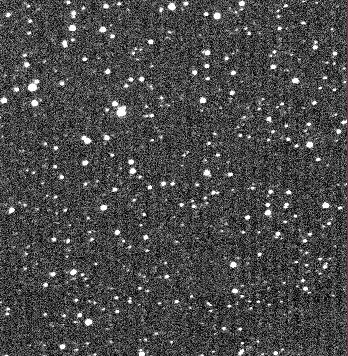
On the night of May 13/14, 2018, in the wee hours of the morning, I acquired a set of observations of the likely black-hole system MAXIJ1820+070, (also known as ASASSN-18ey ). The skies remained cloud-covered until about 4 AM, so I was only able to collect 40 minutes of measurements. Sigh.
The main setup was:
Notes from the night:
I now add one more step to the image processing.
The "vertical stripes" are alternating bright/dark bands which run vertically in images. The bands have a period of 32 unbinned pixels, or 10.666 pixels when binned 3x3. You can see them faintly in the finding chart shown below, or in one of tonight's science images here:

These features are (I believe) due to a small timing error in the readout of the Kodak KAI-11002 CCD. Other astronomers have noticed these bands, and even written software to remove them. There is also a more technical description of the problem, which includes a picture of the effect. Since the bands run top-to-bottom of my images, that document suggests that the error is in the line timing of the readout.
In order to characterize them, I created a col-by-col median vector for each science image (between numbers 1 and 100, before the sky grew too bright), then computed the interquartile mean for each column out of the entire image set. The result showed clearly a variation with amplitude about 4 or 5 pixels/2. The amplitude grows toward the right side of the image (larger column numbers), and also takes a more negative turn.
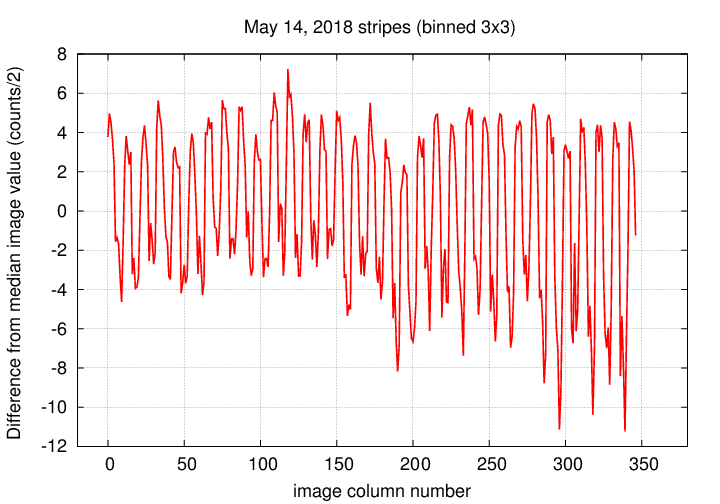
I came up with an ugly model to try to match this variation:
3
[ ( x ) ] ( 2*pi*x ) [ x ]
y(x) = [ 5 + 3.0*(---) ] * cos (------ - 1.2 ) + [ 1.0 - 2.0*(----) ]
[ (400) ] ( 10.666 ) [ 400 ]
It does pretty well for small regions of the image
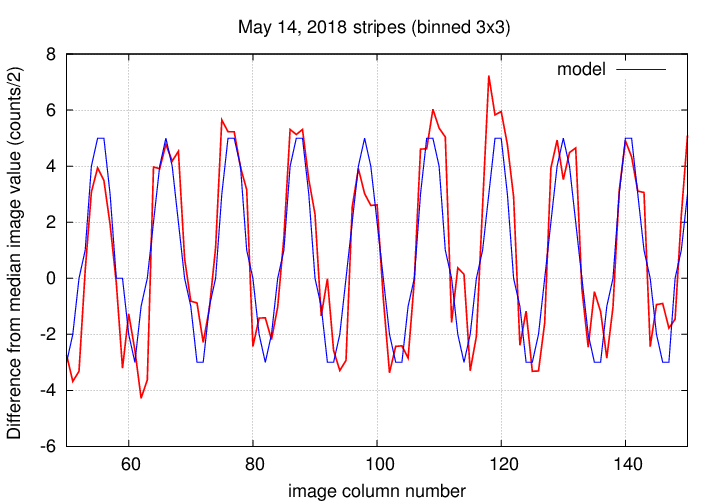
but doesn't match the growing size of the variations toward the right side of the image, alas:
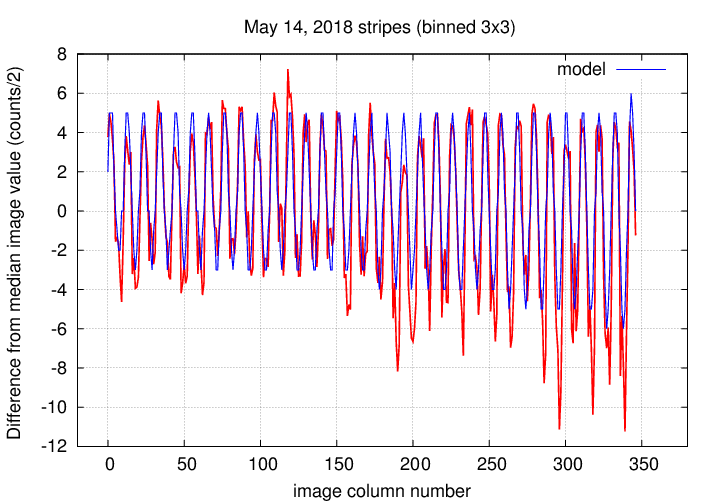
Perhaps I can learn how to tune it better, or even automatically for each night's measurements (the phase term inside the cosine definitely changes from night to night).
Subtracting this model does improve the aesthetic impression of a clean image; before on left, after on right:

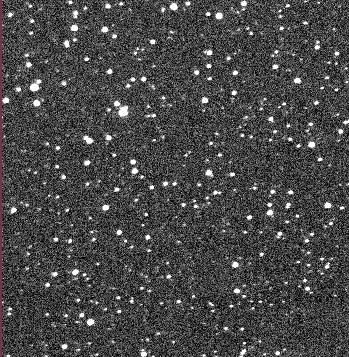
Running the ensemble photometry on the "before" and "after" versions indicates that the scatter in measurements of individual stars is slightly smaller for the "after" version -- especially for faint stars. So, I think I'll continue making this correction.
This optical and X-ray and radio transient is likely a black hole accreting material at a higher-than-usual rate. It has been the subject of many observers over the past two weeks -- see the trail of telegrams that include
The object is located at
RA = 18:20:21.9 Dec = +07:11:07.3
A chart of the field is shown below. The size of the chart is about 22 by 18 arcminutes.
I've marked the location of several comparison stars, which also appear in light curves below. Stars C, D, and E are mentioned by the Tomoe Gozen team in ATel 11426, but all three are rather red, with (B-V) ranging from 1.14 to 1.37. Star B is one of the bluest nearby bright stars, with (B-V) = 0.52.
star UCAC4 B V ---------------------------------------------------- B 486-079513 12.975 12.454 C 486-079608 13.968 12.830 D 486-079523 14.637 13.272 E 487-077858 14.637 13.272 ----------------------------------------------------
The dark current was ordinary.

The sky value shows a bit of cloud at the start, then nothing but the bright sky at dawn. Good!

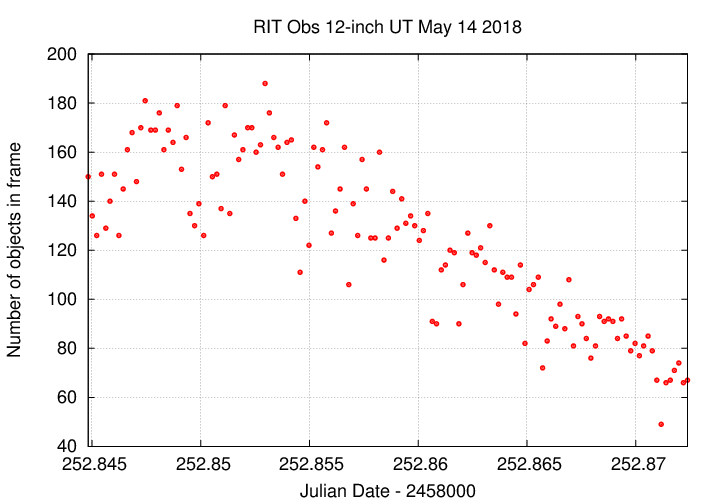
I used an aperture with radius 3.0 pixels.

Image adjustment factor shows nothing unusual; a bit of cloud early.
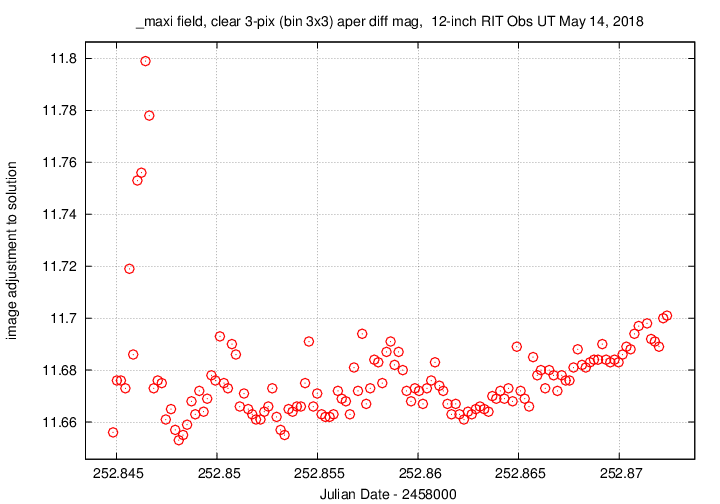
Using aperture photometry with a radius of 3 pixels (binned 3x3, each pixel is 1.98 arcsec, so a radius of 5.9 arcsec), I measured the instrumental magnitudes of a number of reference stars and the target. Following the procedures outlined by Kent Honeycutt's article on inhomogeneous ensemble photometry, I used all stars available in each image to define a reference frame, and measured each star against this frame.
Sigma-vs-mag plots show that the floor was about 0.005 mag overall, much smaller than the 0.010 mag typical of 5-second exposures. Hooray for more photons! The outlier around instrumental magnitude 2 is MAXI J1820+070. Note how much smaller its variations have become -- it used to tower over all the other measurements.
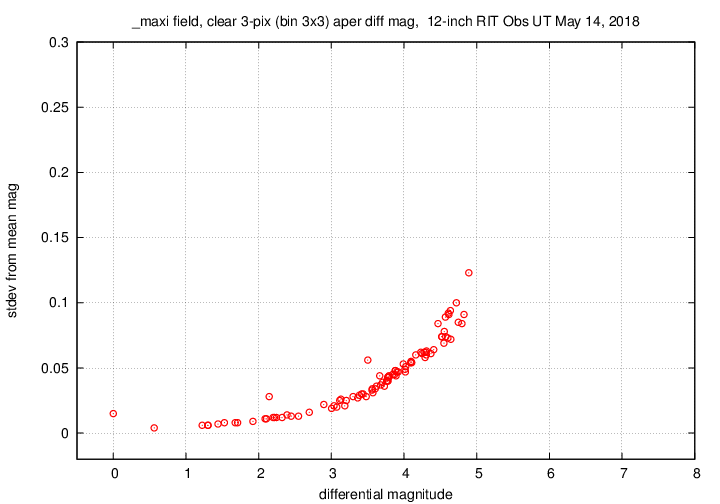
Here are light curves of the variable and the field stars.
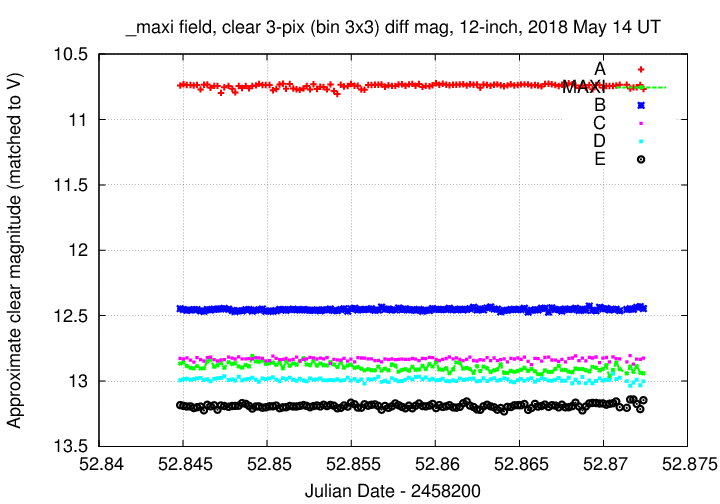
I used the UCAC value for the V-band magnitude of star "B" = UCAC4 486-079513 to shift the ensemble magnitudes to the standard V-band scale -- but remember that these are UNFILTERED measurements.
Here's a closeup on the variable. I'll connect the dots to make its behavior a bit easier to see.
Since I only started observing after the target had risen far above the horizon, there is none of the usual color-dependent extiction.
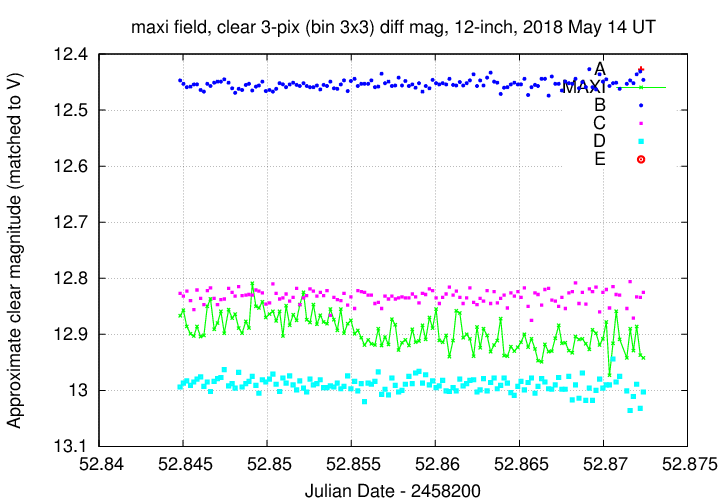
A very short section of the light curve shows how small the short-term variations have become; the longer exposure time (15 sec vs. 5 sec) is also averaging out the fluctuations.

You can download my measurements below. A copy of the header of the file is shown to explain the format.
# Measurements of MAXIJ1820+070 made at RIT Obs, UT 2018 May 14, # in good conditions, # by Michael Richmond, # using Meade 12-inch LX200 and ATIK 11000. # Exposures 15 seconds long, no filter. # Tabulated times are midexposure (FITS header time - half exposure length) # and accurate only to +/- 1 second (??). # 'mag' is a differential magnitude based on ensemble photometry # using a circular aperture of radius 3 pix = 5.9 arcseconds. # which has been shifted so UCAC4 486-079513 has mag=12.454 # which is its V-band magnitude according to UCAC4. # # UT_day JD HJD mag uncert May14.34483 2458252.84483 2458252.84853 12.867 0.011 May14.34502 2458252.84502 2458252.84872 12.857 0.011 May14.34522 2458252.84522 2458252.84892 12.886 0.012
Last modified 5/09/2018 by MWR.